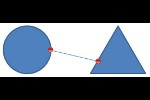All Ribbon tabs in PowerPoint may have
any number of buttons. These buttons represent commands. You'll see that these buttons are not scattered all over the tab area.
In fact, they are all neatly arranged together in Groups. Each of these Groups has a name that describes what
the commands within that Group do. For example, the Slide Show tab in the Ribbon has a group named
Set Up, which contains all commands that help you set up your slide show, such as changing show settings,
hiding slides, rehearsing and recording slide shows, etc.
It is only sensible to imagine that you should use this Group concept while creating your own custom Ribbon tabs. In fact,
PowerPoint will not let you add any command anywhere else other than within a custom Group.
Note that a Group is a part of a Ribbon tab. We have already shown you how to
add a new Ribbon tab. In
Figure 1 below you can see the Insert tab (highlighted in green)
and its default Groups (highlighted in red within Figure 1).

Figure 1: Groups within the Insert tab
These Groups can be customized. Also, when a
new Ribbon tab is added, it contains
a blank new group. This is because all your commands within a tab need to reside in a group. You can opt to rename the new
Ribbon tab and the custom Group as well.
Note: You can customize both the default and custom Groups by renaming them, reordering them, or removing them
altogether. But you cannot add or remove any commands within the default Groups. Commands within custom groups on the other
hand can be added and removed. We explain this in our
Adding Commands to Custom Groups
tutorial.
Now, follow these steps to learn how to work with custom groups within default and custom Ribbon tabs in
PowerPoint 365 for Mac:
- You first need to bring up the Ribbon & Toolbar dialog box. There are two ways to access
this dialog box. The easier way is to click the down-arrow on the
Quick Access Toolbar, as shown
highlighted in red within Figure 2, and then choose the
More Commands option from the resultant menu.
-

Figure 2: More Commands option
- Alternatively, choose the PowerPoint | Preferences menu option
as shown in Figure 3.
-

Figure 3: PowerPoint | Preferences menu option
- This opens the PowerPoint Preferences dialog box, as shown in
Figure 4. Within this dialog box, select the Ribbon & Toolbar option (highlighted
in red within Figure 4).
-

Figure 4: Ribbon & Toolbar option
- Either way, this opens the Ribbon & Toolbar dialog box, as shown in
Figure 5. Make sure that the Ribbon tab is selected (refer to Figure 5
again). Note that we added a new Ribbon
tab (highlighted in red within Figure 5), and this tab contains a new Group
named Tools We Use.
-

Figure 5: Ribbon & Toolbar dialog box showing Custom group within new Ribbon tab
- Now we will add a new group to the Draw tab. Note that this is one of the default
tabs of the Ribbon as shown in Figure 6 below. You can add groups to both default and custom Ribbon tabs
in the same way.
-

Figure 6: Draw tab of the Ribbon
- To add a new group, select the tab to which you want to add a new group. For our example, we selected the
Draw tab (highlighted in red within Figure 7), and clicked
the Plus button (highlighted in green within Figure 7).
From the resultant menu, select the New group option (refer to Figure 7 again).
-

Figure 7: Add a new group within a default tab
- Doing so adds a new group within the Draw tab, as shown highlighted in
red within Figure 8, below.
-

Figure 8: New group added
- Select the newly added custom Group as shown in Figure 9. Then, click the
Settings button (highlighted in red within Figure 9). This brings
up a contextual menu. Within this menu, select the Rename option, as shown in Figure 9.
-

Figure 9: Settings menu
- In the resultant window, provide a name to the newly added group as shown in Figure 10, and
click the Save button.
-

Figure 10: Rename the Custom Group
- Doing so changes the name of the new group, as shown highlighted in red within
Figure 11.
-

Figure 11: Custom Group with new name
- You can also reorder the newly added group within the same tab. To do so, select the group and drag it to
the new position in the same tab. In Figure 12, you can see that we are dragging the new group to place
it above all existing groups.
-

Figure 12: Reorder the Custom group
- This action changes the position of the custom group, as shown in Figure 13.
-

Figure 13: New group with changed position
- Add some commands to the new group as explained in our
Adding Commands to Custom Groups
tutorial. We added two commands to the new Shapes group that we added to the Draw default
tab. In Figure 14 you can see the result of adding and reordering the new group within the
Draw tab (highlighted in red). Compare Figure 6 and
Figure 14 to see the difference.
-

Figure 14: New group showing in the Draw tab of the Ribbon
- To remove a custom group, access the Ribbon & Toolbar dialog box as explained at the
beginning of this tutorial, select the custom group to be deleted, and click the Minus (-)
button, as shown highlighted in red within Figure 15. This action will remove
the custom group along with all commands added to it.
-

Figure 15: Delete the custom group


















